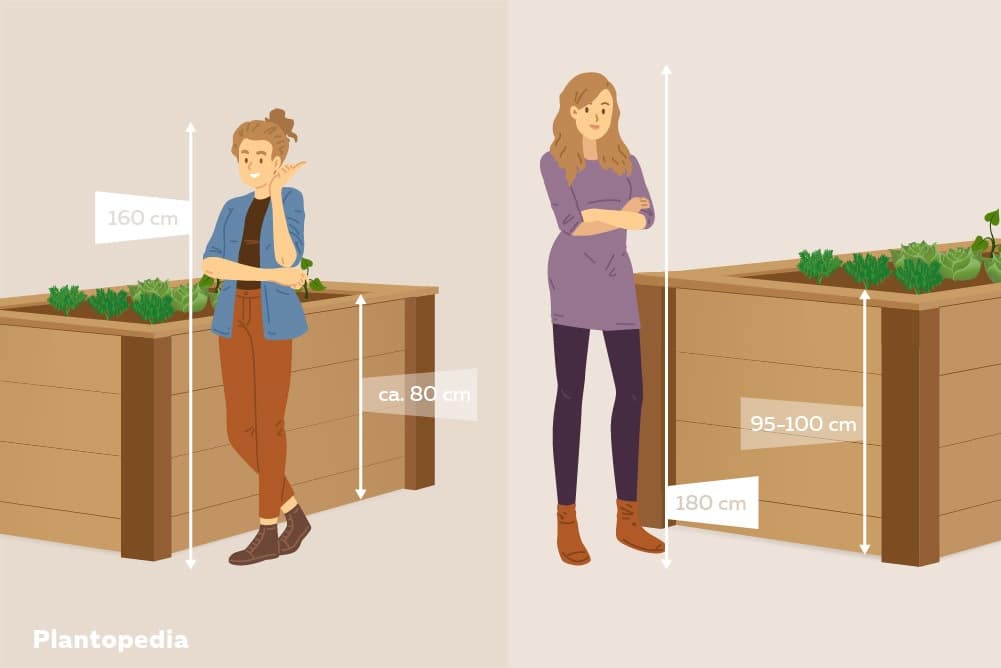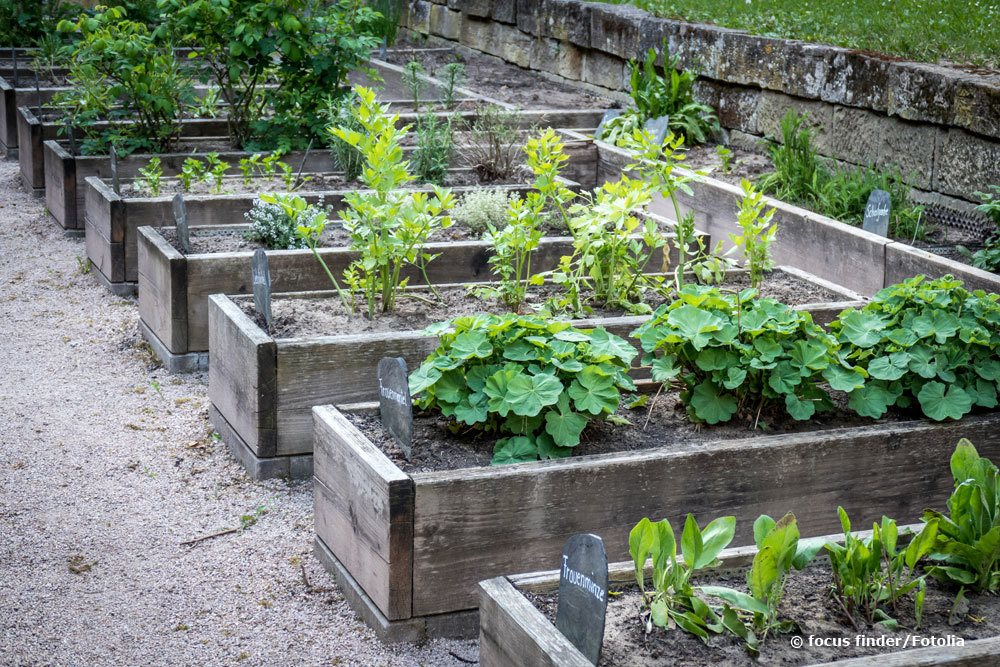Before you create a raised bed, it is necessary to find out the very individual ideal dimensions. After all, it should not only be easy on the back, but also stable and easy to work with.
Contents
The right height
When choosing the perfect height for a raised bed, there are several factors to consider.
Height
For many gardeners, the primary reason for purchasing or building a raised bed is to be able to garden comfortably and upright without back pain. Accordingly, the height must be adapted to one’s own body size. If the working height is set too low or too high, the gardener will have to adopt a poor posture. If the raised beds are too low, you will be forced to bend forward, putting strain on your spinal discs. Too high a working height is also problematic. It requires a lot of effort, strains the shoulder girdle and possibly overstretches the spine.
Top edge at about pelvic height:
- Body height around 150 cm: bed height approx. 75 cm
- Body height around 160 cm: bed height about 80 cm
- Body height around 170 cm: bed height about 90 cm
- Body height over 180 cm: bed height 95 to 100 cm

If two or more people are to participate in the cultivation of the raised bed, who have a very different height, it may be useful to create several raised beds with different height dimensions. Inasmuch as your garden has a natural slope, two different heights can easily be created on two sides of the raised bed.
Elbow height as a yardstick:
While the optimal working height used to be determined based on body height, this method is now considered too inaccurate because it does not take into account individual body measurements. The ideal solution is to use elbow height to determine the right height. It is best to try out the determined raised bed height in advance in your living room. Stack a few books or magazines on the table and see if you feel comfortable. Keep in mind that the bed will not be filled to the brim with soil and that plants will be added to the bed height.
Distance between the elbow and the surface of the soil in the raised bed: 15 to 20 cm.
Filling height: about 5 to 10 cm below the edge
To ensure that you can work in an ergonomic posture for several hours a week, it is best to orient yourself to the height of your kitchen counter. If the height of the work surface in the kitchen allows you to work for longer periods of time comfortably and without pain, simply subtract 10 cm and take the measurement for the raised bed.
Tip: If you are one of those people who like to lean their pelvis when working while standing, take your belly button height as a measurement and don’t fill in quite as much soil.
Raised beds for sitting
Some gardeners prefer to work on their raised beds while sitting down. In this case, you should try out in advance what height is ideal. However, the sitting edge should be at least 50 centimeters high, otherwise you may find it difficult to stand up. In addition, a stable, wide edge for comfortable sitting is an important requirement so that you can work comfortably on the bed.
By the way, half-height raised beds are also recommended for children, who can garden on them while standing.

Location
If you place the raised bed in the garden, in principle, the dimensions can be freely chosen. However, caution is advised wherever the space is free-floating, such as on a balcony. The same applies if the site is located above a room, such as roof terraces. In this case, the box filled with soil must not become too heavy. Keep in mind that a size of only about 100 x 200 cm with a height of 80 cm already adds up to over 1600 liters. Including irrigation water, a weight of about 700 to 900 kg then acts on the substrate. This is clearly too much for most balconies and roof terraces and can lead to cracks in the building structure. The average load capacity is about 200 to 300 kg per square meter. Regardless of the length, this results in approximately the following dimensions:
- Depth 100 cm: maximum 40 cm high
- Depth 60 cm: maximum 65 cm high
- Depth 50 cm: maximum 80 cm high
Tip: If in doubt, ask your developer or property management about the load-bearing capacity of the balcony or roof garden to be on the safe side.
The ideal width
To ensure that you can work comfortably, the following rule applies to the width of a raised bed: the dimensions should correspond to twice your arm’s length, provided it is positioned so that you can walk on it from both sides. If the raised bed can only be walked on from one side, for example because it is against a wall or hedge, the maximum width is one arm’s length. On average – assuming you keep your back straight – you can only reach about 55 to 70 cm, depending on your arm length. If you are very tall or shorter than average, it is better to measure your arm length in advance and adjust the dimensions of the raised bed accordingly.
- Width (walking on both sides): 100 to 120 cm
- transverse dimension (one-sided access): 60 to 70 cm
- for taller people: up to a maximum width of 140 cm
- Working in a sitting position or with a rollator: max. 100 cm
The optimal length
When it comes to the length of your raised bed, they are more flexible. In principle, it can be any length. However, it is essential to pay attention to the stability. The filling can become quite heavy and with its weight not only press down, but also on the walls. Long plastic or wooden slats, simple constructions made of pallets or screwed boards, as well as raised beds made of stone will be pressed apart. For very long raised beds, reinforcements should be used for this reason. However, it is easier and also more stable to divide the raised bed and rather build two or three shorter versions with a maximum length of 200 cm.
- Ratio of width to length: 1 to 2 to 1 to 4
- not longer than 2 m
Tip: When building your raised bed, do not forget that it must also be easily accessible. On a path about 80 cm wide, even a wheelbarrow can be used without problems.
Raised bed for children
If you want to build a small raised bed for your children or grandchildren, the dimensions are clearly too large for adults. However, keep in mind that children grow quickly. Ideally, the bed can be adjusted in height dimensions, then you will all enjoy it for a long time.
Raised beds come in many colors, shapes and sizes. There are small raised beds for the balcony, large vegetable raised beds in the kitchen garden or privacy beds in front of the terrace. There are table raised beds, low stair raised beds and many more. What all these shapes have in common is that they should be built according to ergonomic principles in terms of height, depth and length – otherwise you may get back pain.
Those who put a raised bed in their garden often do so for the sake of comfortable gardening. After all, pretty much every gardener knows the feeling that sets in after a long afternoon weeding the garden: Excruciating back pain that, with a little bad luck, will stay with you for a few days to weeks. Ideally, the raised bed is designed so that you can comfortably work on it standing or sitting and reach everywhere.
How deep can a raised bed be?
In terms of height, such a bed should reach up to your pelvis – i.e. be between 80 and 100 centimeters high, depending on your height. If, on the other hand, you want to work on the raised bed while sitting down, a height of between 50 and 60 centimeters is recommended, as well as an integrated seat. The bed depth or width, in turn, depends on your arm length. As with countertops, for example for the built-in kitchen, it is best to assume 120 to 140 centimeters for a free-standing bed that can be walked on from both sides. A leaning bed, on the other hand, should be no wider than 60 to 70 centimeters; after all, you can only reach it from one side.
Tips
If you want to build a small raised bed for your children, you must of course use adapted dimensions – an adult-sized raised bed is simply too big and therefore too uncomfortable for the little ones. However, you should also keep in mind that children grow quickly. Ideally, the raised bed can be adjusted in height and depth – then you and your kids will enjoy it all the longer.

